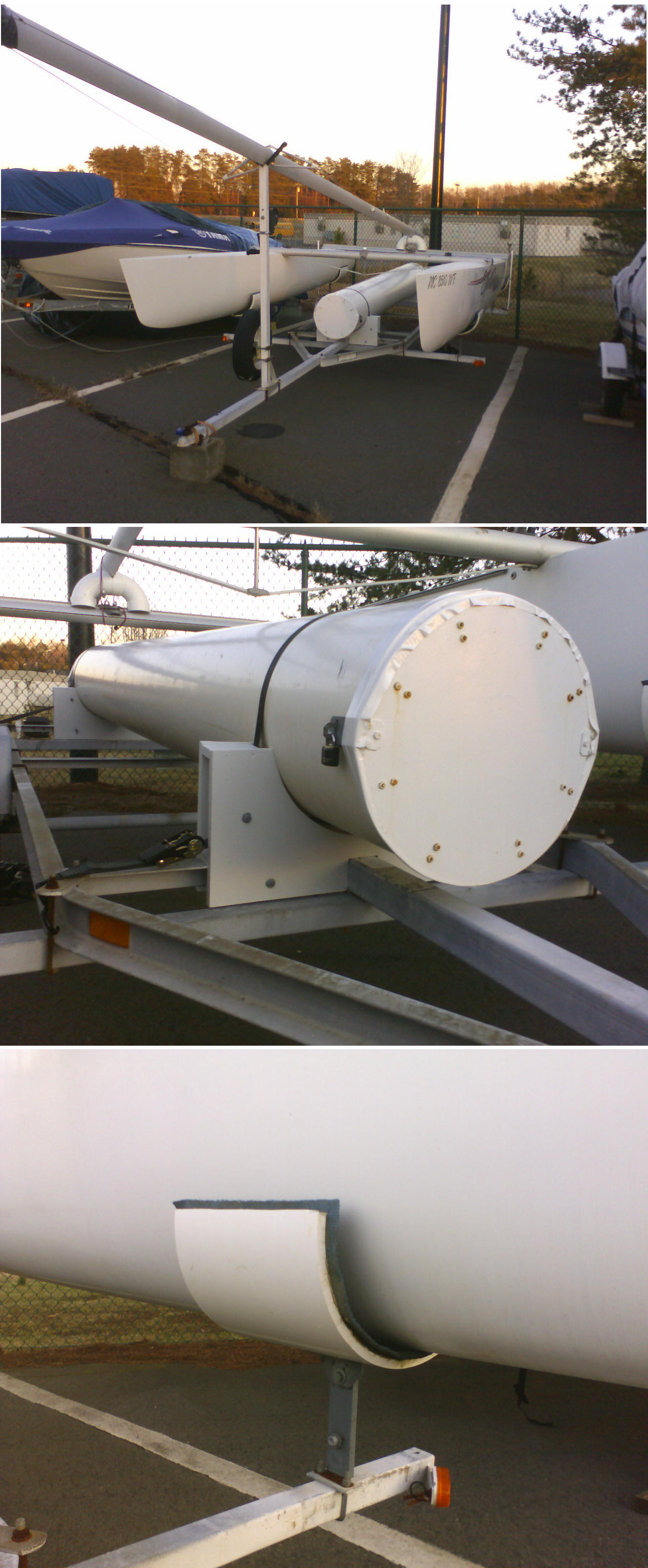I keep reading that I should toss my rollers and make some of my own cradles. I would like to see some photos or plans so I can do this.
Thanks.
A
Home made hull cradle plans.

-
- Rank: Lubber
- Registered: Jul 27, 2008
- Last visit: Oct 09, 2011
- Posts: 8
-
- Rank: Lubber
- Registered: Dec 09, 2008
- Last visit: Apr 06, 2011
- Posts: 99
I did some research into this a few months back and found an article that described turning your hull upside down to create a form. Basically using a mold release type barrier and laying fiberglass on the hull bottom to make the cradle form an exact match. -
- Rank: Mate
- Registered: Apr 24, 2005
- Last visit: Apr 18, 2023
- Posts: 709
If you make an exact mold use the hulls make sure you add material to simulate the carpet or other padding you will put in the cradle once complete.
--
Scott,
‘92 H18 w/SX wings
‘95 Hobie Funseeker 12 (Holder 12)
‘96/‘01/‘14 Hobie Waves
-- -
- Rank: Mate
- Registered: Oct 19, 2006
- Last visit: Aug 16, 2017
- Posts: 613
I'm getting pretty tired of the roller bracket tearing up the gelcoat on my H16, if you don't get the boat lined up just right loading or unloading, the hull slips off the roller and another scratch is added. I'm looking at using 16" - 18" PVC pipe, cut into half round, mount to trailer, add carpet to cover flat head mounting bolts and see if that works better. Missed the set of 4 hull cradles Dave had up for sale.
--
TurboHobo
H14T
H16
P18
G-Cat 5.0
P16
-- -
- Rank: Master Chief
- Registered: Jun 20, 2006
- Last visit: Dec 04, 2024
- Posts: 7090
If you remove all the rollers, how do you get the boat into the correct place?
i have rear craddles... they are not an exact fit (not even close) but as i slide my boat the hull shape changes so if i had a perfect fit cradles, it would get major stress every time my boat slides in and out of its final position on the trailer -
- Rank: Mate
- Registered: Oct 19, 2006
- Last visit: Aug 16, 2017
- Posts: 613
18" half round PVC would leave ample play needed for the variance in hull shape. And I would make sure the lip of the PVC is padded, either by overlapping the carpet or by gluing on pipe isulation foam.
--
TurboHobo
H14T
H16
P18
G-Cat 5.0
P16
-- -
- Rank: Lubber
- Registered: Jun 18, 2008
- Last visit: Jul 02, 2009
- Posts: 36
THREE CHEERS FOR PVC!!! Thaaaaaas exactly what I did. Picked up a piece of scrap 18" pvc sewar pipe at a construction yard. Made a storage tube and cut off two sets of 1-foot setions which I cut in half. Thick, padded-carpeted and mounted to the trailer. It's lasted for... 10 years now! I'm always concerned about it's strength and what the UV sunlight does to it, so 2-3 times a year with the boat off the trailer, I stand on each of the cradles - all 225 pounds of me. Hasn't broken yet! Pic below, although I doubt it will show up, so I included a link.
http://www.beginnertriathlete.com/discussion/photos/get-photo.asp?photoid=85383 -
- Rank: Lubber
- Registered: Aug 12, 2009
- Last visit: Sep 22, 2011
- Posts: 36
Ok, they look good, but exactly how did you mount / attach the PVC half pipe to the bracket thingy below it...that I can see in the last picture?
Thanks! -
- Rank: Chief
- Registered: Jun 24, 2009
- Last visit: Jun 15, 2023
- Posts: 1555
Oh great, now I HAVE to find me some PVC sewer pipe! Great stuff!
--
Dave Bonin
1981 Nacra 5.2 "Lucile"
1986 Nacra 5.7 "Belle"
Winnipeg, Manitoba, Canada
-- -
- Rank: Mate
- Registered: Oct 19, 2006
- Last visit: Aug 16, 2017
- Posts: 613
Just find your local water and sewer supply dealer, they will carry all types of PVC. A road in my area has construction going on and I picked up a 4' length of PVC pipe that will be perfect for my new hull cradles. White PVC is the thinnest at about 4mm, green PVC is 6mm and blue PVC 8mm, something to do with what it's used for, water white, sewer green, gas blue. I looked at a 5' length of the green PVC but was amazed/shocked at the weight, I could barely lift it. Drill holes through PVC and use a flat-topped carriage bolt, once attached to trailer cover head of carriage bolt with a generous dollop of silicone, when that has set, lay down strip of carpet.
Turbo -
- Rank: Mate
- Registered: Jun 26, 2009
- Last visit: Mar 20, 2015
- Posts: 150
Close... has more to do with pressure rating than and burial depth than what the pipe is carrying. Gas is almost always in yellow High Density Polyethlene (HDPE)pipe with heat fused joints. Solvent welded or gasketed joints typically used with PVC are not always gas tight. Typically blue pipe is high pressure water main.




